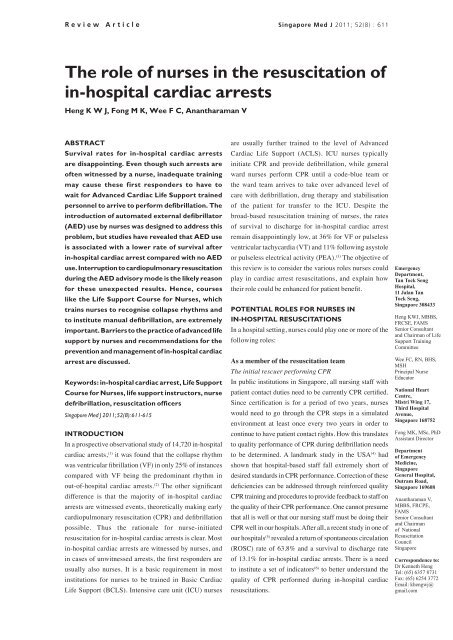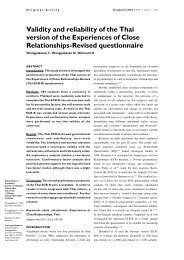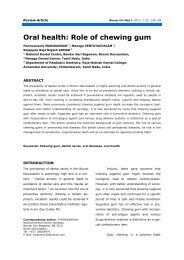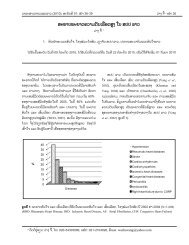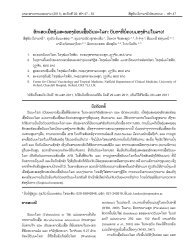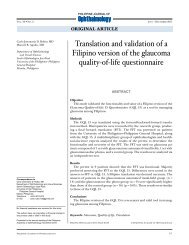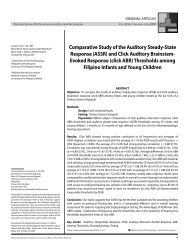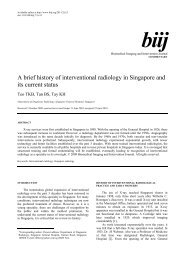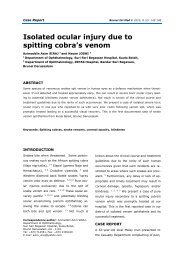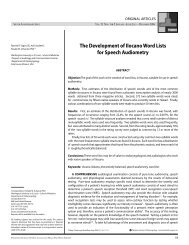PDF ( B) - APAMED Central
PDF ( B) - APAMED Central
PDF ( B) - APAMED Central
Create successful ePaper yourself
Turn your PDF publications into a flip-book with our unique Google optimized e-Paper software.
Review Article<br />
Singapore Med J 2011; 52(8) : 611<br />
The role of nurses in the resuscitation of<br />
in-hospital cardiac arrests<br />
Heng K W J, Fong M K, Wee F C, Anantharaman V<br />
ABSTRACT<br />
Survival rates for in-hospital cardiac arrests<br />
are disappointing. Even though such arrests are<br />
often witnessed by a nurse, inadequate training<br />
may cause these first responders to have to<br />
wait for Advanced Cardiac Life Support trained<br />
personnel to arrive to perform defibrillation. The<br />
introduction of automated external defibrillator<br />
(AED) use by nurses was designed to address this<br />
problem, but studies have revealed that AED use<br />
is associated with a lower rate of survival after<br />
in-hospital cardiac arrest compared with no AED<br />
use. Interruption to cardiopulmonary resuscitation<br />
during the AED advisory mode is the likely reason<br />
for these unexpected results. Hence, courses<br />
like the Life Support Course for Nurses, which<br />
trains nurses to recognise collapse rhythms and<br />
to institute manual defibrillation, are extremely<br />
important. Barriers to the practice of advanced life<br />
support by nurses and recommendations for the<br />
prevention and management of in-hospital cardiac<br />
arrest are discussed.<br />
Keywords: in-hospital cardiac arrest, Life Support<br />
Course for Nurses, life support instructors, nurse<br />
defribrillation, resuscitation officers<br />
Singapore Med J 2011; 52(8): 611-615<br />
INTRODUCTION<br />
In a prospective observational study of 14,720 in-hospital<br />
cardiac arrests, (1) it was found that the collapse rhythm<br />
was ventricular fibrillation (VF) in only 25% of instances<br />
compared with VF being the predominant rhythm in<br />
out-of-hospital cardiac arrests. (2) The other significant<br />
difference is that the majority of in-hospital cardiac<br />
arrests are witnessed events, theoretically making early<br />
cardiopulmonary resuscitation (CPR) and defibrillation<br />
possible. Thus the rationale for nurse-initiated<br />
resuscitation for in-hospital cardiac arrests is clear. Most<br />
in-hospital cardiac arrests are witnessed by nurses, and<br />
in cases of unwitnessed arrests, the first responders are<br />
usually also nurses. It is a basic requirement in most<br />
institutions for nurses to be trained in Basic Cardiac<br />
Life Support (BCLS). Intensive care unit (ICU) nurses<br />
are usually further trained to the level of Advanced<br />
Cardiac Life Support (ACLS). ICU nurses typically<br />
initiate CPR and provide defibrillation, while general<br />
ward nurses perform CPR until a code-blue team or<br />
the ward team arrives to take over advanced level of<br />
care with defibrillation, drug therapy and stabilisation<br />
of the patient for transfer to the ICU. Despite the<br />
broad-based resuscitation training of nurses, the rates<br />
of survival to discharge for in-hospital cardiac arrest<br />
remain disappointingly low, at 36% for VF or pulseless<br />
ventricular tachycardia (VT) and 11% following asystole<br />
or pulseless electrical activity (PEA). (3) The objective of<br />
this review is to consider the various roles nurses could<br />
play in cardiac arrest resuscitations, and explain how<br />
their role could be enhanced for patient benefit.<br />
POTENTIAL ROLES FOR NURSES IN<br />
IN-HOSPITAL RESUSCITATIONS<br />
In a hospital setting, nurses could play one or more of the<br />
following roles:<br />
As a member of the resuscitation team<br />
The initial rescuer performing CPR<br />
In public institutions in Singapore, all nursing staff with<br />
patient contact duties need to be currently CPR certified.<br />
Since certification is for a period of two years, nurses<br />
would need to go through the CPR steps in a simulated<br />
environment at least once every two years in order to<br />
continue to have patient contact rights. How this translates<br />
to quality performance of CPR during defibrillation needs<br />
to be determined. A landmark study in the USA (4) had<br />
shown that hospital-based staff fall extremely short of<br />
desired standards in CPR performance. Correction of these<br />
deficiencies can be addressed through reinforced quality<br />
CPR training and procedures to provide feedback to staff on<br />
the quality of their CPR performance. One cannot presume<br />
that all is well or that our nursing staff must be doing their<br />
CPR well in our hospitals. After all, a recent study in one of<br />
our hospitals (5) revealed a return of spontaneous circulation<br />
(ROSC) rate of 63.8% and a survival to discharge rate<br />
of 13.1% for in-hospital cardiac arrests. There is a need<br />
to institute a set of indicators (6) to better understand the<br />
quality of CPR performed during in-hospital cardiac<br />
resuscitations.<br />
Emergency<br />
Department,<br />
Tan Tock Seng<br />
Hospital,<br />
11 Jalan Tan<br />
Tock Seng,<br />
Singapore 308433<br />
Heng KWJ, MBBS,<br />
FRCSE, FAMS<br />
Senior Consultant<br />
and Chairman of Life<br />
Support Training<br />
Committee<br />
Wee FC, RN, BHS,<br />
MSH<br />
Principal Nurse<br />
Educator<br />
National Heart<br />
Centre,<br />
Mistri Wing 17,<br />
Third Hospital<br />
Avenue,<br />
Singapore 168752<br />
Fong MK, MSc, PhD<br />
Assistant Director<br />
Department<br />
of Emergency<br />
Medicine,<br />
Singapore<br />
General Hospital,<br />
Outram Road,<br />
Singapore 169608<br />
Anantharaman V,<br />
MBBS, FRCPE,<br />
FAMS<br />
Senior Consultant<br />
and Chairman<br />
of National<br />
Resuscitation<br />
Council<br />
Singapore<br />
Correspondence to:<br />
Dr Kenneth Heng<br />
Tel: (65) 6357 8731<br />
Fax: (65) 6254 3772<br />
Email: khengwj@<br />
gmail.com
Singapore Med J 2011; 52(8) : 612<br />
In the meantime, there is a need to emphasise the<br />
importance of performance of good quality CPR by<br />
our ward nurses. All wards should be provided with the<br />
necessary resources to ensure a better quality of CPR,<br />
e.g. a step stool to ensure that the rescuer is vertically<br />
above the patient and able to confidently perform good<br />
quality chest compressions and a CPR counter to ensure<br />
correct rate of compressions and to remind rescuers<br />
not to interrupt these unnecessarily. Any person who<br />
performs CPR should be providing the best possible<br />
quality in the hospital, whether that person is a doctor or<br />
nurse. This can only be achieved if the person recognises<br />
and is convinced of the importance of good quality<br />
chest compressions. Therefore, refresher training with<br />
emphasis on quality is crucial.<br />
Managing defibrillation<br />
It is well documented that early defibrillation leads to<br />
optimum outcomes, (7) and as most defibrillator machines<br />
may be readily switched from manual to automated<br />
external defibrillator (AED) mode with shock advisory,<br />
AED use is now regarded as a core skill for general<br />
ward nurses. (8-10) Some hospitals combine BCLS and<br />
AED training into a single entity. Widespread training<br />
of nurses to use the AED would allow them to institute<br />
early defibrillation regardless of their level of training.<br />
It was postulated that this strategy would lead to earlier<br />
defibrillation of pulseless VT or VF, better rates of ROSC<br />
and improved rates of survival to discharge. On the other<br />
hand, it is hypothesised that AED use should not impact<br />
ROSC rates or survival to discharge of patients with<br />
asystole or PEA arrest.<br />
However, Chan et al (11) demonstrated that AED<br />
use was associated with a lower rate of survival after<br />
in-hospital cardiac arrest compared with no AED use<br />
(16.3% vs. 19.3%; p = 0.001). Among cardiac arrest due<br />
to non-shockable rhythms, AED use was associated with<br />
lower survival (10.4% vs. 15.4%; p = 0.001). In contrast,<br />
for cardiac arrest due to shockable rhythms, AED use<br />
was not associated with improved survival (38.4% vs.<br />
39.8%; p = 0.99). These patterns were consistently<br />
observed in both monitored and non-monitored hospital<br />
units where AEDs were used. Forcina et al (12) reported<br />
similar findings. These unexpected findings were<br />
attributed to more frequent interruptions to CPR during<br />
AED use. During the advisory mode, AEDs instruct<br />
rescuers to stop CPR during rhythm analysis and while<br />
charging to deliver a shock. In one study of out-ofhospital<br />
cardiac arrests, chest compressions were only<br />
actively administered during 40% of the resuscitation<br />
time owing to interruptions by AED commands and other<br />
resuscitation tasks. (13) Due to these findings, rescuers are<br />
often advised to switch from advisory mode to manual<br />
defibrillator immediately upon arrival of ACLS-trained<br />
staff. Until AED technology improves, there may be<br />
a need to elevate the skills of general ward nurses to<br />
recognise shockable rhythms and deliver defibrillation.<br />
The need to closely interface AED use with almost<br />
uninterrupted CPR for best effect must be emphasised,<br />
and our nurses need to be brought up in such a culture.<br />
Managing airway and ventilation<br />
While ACLS is beyond the scope of most general ward<br />
nurses, a life support course that bridges the gap between<br />
BCLS and ACLS and equips nurses with knowledge and<br />
practical resuscitation skills is needed. The Life Support<br />
Course for Nurses (LSCN) was created in 1999 under<br />
the auspices of the National Resuscitation Council of<br />
Singapore. It teaches nurses advanced airway skills such<br />
as laryngeal mask ventilation, endotracheal intubation,<br />
rhythm recognition, defibrillation and simplified drug<br />
therapy. Around the world, similar courses have also<br />
been implemented. (9,10,14,15) All nurses need to be familiar<br />
with insertion of an oral airway and effective use of a<br />
bag-mask ventilator.<br />
Managing lines, drugs and tubes<br />
Once it is ensured that one person is managing the<br />
chest compressions and another the ventilations, the<br />
other components of a good resuscitation come into<br />
play. Intravenous lines need to be placed for drug and<br />
fluid delivery, and sometimes, tubes such as bladder<br />
catheter and intra-arterial lines can enhance circulatory<br />
management. Even if nursing staff do not place these<br />
lines, they have an important role in managing the<br />
catheters, administering or helping to administer<br />
drugs and infusions as well as ensuring that these are<br />
maintained. It is important that at least one person is<br />
dedicated to these functions.<br />
As the staff in charge of resuscitation documentation<br />
It is common practice in most areas of the hospital to<br />
document the details of the resuscitation only at the end.<br />
This often results in approximation of number of doses<br />
of drugs delivered, timing of shocks and their magnitude,<br />
and the order of resuscitation. This does not allow a<br />
fully accurate picture of the resuscitation to be captured<br />
for subsequent evaluation and audit for continuous<br />
improvement. Accurate documentation is critical in<br />
resuscitations if we hope to learn from each patient<br />
and make future improvements. A few perspectives are<br />
relevant to documentation.
Singapore Med J 2011; 52(8) : 613<br />
Implementing Utstein-style reporting<br />
Hospitals in Singapore generally do not use standard<br />
reporting systems for their resuscitations. As a result,<br />
we do not have a unified understanding of the common<br />
challenges different institutions face in the conduct<br />
of resuscitations. A common reporting system (6) has<br />
been developed for in-hospital cardiac arrests, which<br />
is being used increasingly in a number of countries.<br />
Any documentation system requires diligence in order<br />
to ensure completeness and usefulness. This requires<br />
attention to completing all aspects of documentation<br />
as accurately as possible. Nursing staff are known for<br />
their diligence in documentation of procedures. They<br />
should take charge of completing the reporting form for<br />
in-hospital cardiac arrests in the Utstein style. This will<br />
allow us to begin a standard form of documentation that<br />
will give a more complete picture as to how we manage<br />
our patients as well as a common language to discuss our<br />
resuscitative practices.<br />
Prompting team members of critical actions required<br />
It is important to ensure that all aspects of a resuscitative<br />
sequence have been adequately examined in the<br />
management of a cardiac arrest patient. The use of<br />
checklists to guide resuscitations can add a new dimension<br />
to ensuring completeness of the resuscitation attempt.<br />
With the use of such checklists, the resuscitation nurse<br />
leader may prompt resuscitation team members of the<br />
various areas they need to consider as they proceed with<br />
their resuscitation. Such checks can also be useful from<br />
a subsequent debrief perspective and will help to ensure<br />
that in time, all members of the resuscitation team will<br />
become better versed with all aspects of the resuscitation<br />
sequence.<br />
Ensuring all follow-up actions are completed<br />
Following the completion of a resuscitation, there<br />
is a need to ensure that all resuscitation records are<br />
captured, including timings of interventions and drug<br />
administration, printout of defibrillation sequences from<br />
the defibrillator and printout from the CPR feedback<br />
device. This must be carried out as a bundled checklist.<br />
Our nurses can fulfil this function by ensuring that all<br />
these documents are available during the resuscitation<br />
debrief.<br />
As a hospital resuscitation officer<br />
Many hospitals in the UK have appointed resuscitation<br />
officers to take charge of the implementation of<br />
resuscitation guidelines, ensure that all staff are trained<br />
appropriately, maintain training standards, monitor quality<br />
of resuscitations and report regularly to the hospitals’<br />
resuscitation committees or governance boards on the<br />
quality of resuscitation conducted in the hospital. Some of<br />
these officers are nurses who have spent years involved in<br />
various aspects of resuscitation training, are very familiar<br />
with life support practices and understand the need for<br />
high resuscitation standards. McGowan et al (16) reported<br />
that the appointment of a resuscitation training officer is<br />
associated with improved survival from in-hospital VF or<br />
VT arrest. Nurses could contribute tremendously in this<br />
role.<br />
As a resuscitation instructor<br />
Many nurses teach life support in our various hospitals.<br />
They contribute tremendously to helping the various<br />
grades of healthcare workers learn the skills of CPR. Most<br />
life support training centres face shortages of instructors,<br />
which often affect their ability to train more persons in<br />
the critical skills of life saving. Nurses are in a privileged<br />
position in society, being trained healthcare workers with<br />
the ability to pass on to members of the community the<br />
basic life saving skills of CPR and the use of an AED.<br />
There is a need to consider training every nurse to the<br />
level of a CPR or CPR+AED instructor and requesting<br />
our nurses to continue as instructors for at least five years,<br />
teaching in life support courses at least twice annually.<br />
Not only will this demonstrate their commitment to<br />
saving lives in the community, but being an instructor also<br />
sharpens the skills for the procedure they are teaching.<br />
Instructing regularly will ensure that our nurses are not<br />
only knowledgeable and up to date with the various aspects<br />
of CPR, but it will also ensure that they are able to provide<br />
the highest standard of CPR any rescuer can provide. This<br />
way, they serve as role models for the burgeoning army of<br />
citizen first responders in the country. They will be able<br />
to teach in the various areas of the country where such<br />
instruction is required. In addition, they may volunteer<br />
their services in the various constituencies, especially in<br />
those close to where they live or work. This will address a<br />
real need in the country.<br />
BARRIERS TO NURSE-INITIATED<br />
RESUSCITATION<br />
Passing a course like LSCN only fulfils the first three<br />
stages of Miller’s pyramid of competency (17) (Fig. 1),<br />
where the trainee progresses from ‘knows’, ‘knows how’<br />
to ‘shows how’. Such early competency only describes<br />
what an individual is able to do in clinical practice,<br />
while what an individual actually does, the highest<br />
level in Miller’s pyramid, is often the most challenging<br />
transition to make, and fraught with many barriers.
Singapore Med J 2011; 52(8) : 614<br />
Numerous publications and surveys have identified<br />
consistent barriers to the practice of advanced skills like<br />
defibrillation. These include lack of confidence, fear of<br />
incurring litigation and harming the patient or themselves,<br />
perceived difficulty in interpreting electrocardiograph<br />
rhythms, entrenched ‘supportive’ role of nurses in<br />
resuscitation and the lack of practising privilege by the<br />
policy makers. (15,19,20) Strategies that have been suggested<br />
to overcome these barriers include making defibrillation<br />
a prevalent and accepted core nursing procedure. (20) To<br />
address this reticence and effect a cultural change, nurses<br />
need to re-examine their role in resuscitation more closely<br />
and demonstrate that nurse-led resuscitation does lead to<br />
improved patient survival.<br />
When given front-line roles in resuscitation, nurses have<br />
been shown to be capable leaders. Giligan et al (21) reported<br />
that advanced life support (ALS)-trained emergency nurses<br />
performed as well as ALS-trained and non ALS-trained<br />
emergency junior doctors in a simulated cardiac arrest<br />
situation. The nurses had better applied knowledge of<br />
the potentially reversible causes of cardiac arrest. It was<br />
suggested that in the absence of a senior or middle-grade<br />
emergency doctor, it might be appropriate for ALS-trained<br />
nursing staff to act as the resuscitation leader, rather than the<br />
junior doctor.<br />
RECOMMENDATIONS<br />
Prevention of cardiac arrest is key, and factors contributing<br />
to poor outcomes, such as a lack of monitoring of vital<br />
parameters or recognition of early warning signs (e.g.<br />
deterioration of these parameters) by nursing staff, variable<br />
quality of CPR due to rescuer fatigue and cardiac arrests<br />
occurring during periods of low staffing, (22) after hours<br />
and over weekends, can all be identified and rectified.<br />
There is a need for systems to be in place to effect these.<br />
A multi-pronged approach to address these factors must<br />
include staff education in order to detect deterioration<br />
and implementation of criteria for escalation of care.<br />
Some hospitals have medical emergency teams (METs)<br />
that respond to any patient who is acutely unwell. Their<br />
role is to correct the patient’s deranged physiology and<br />
prevent cardiac arrest. CPR-feedback devices can identify<br />
deterioration in rescuer performance and signal a need to<br />
change rescuer. Mechanical CPR devices provide consistent<br />
high-quality CPR and have the added advantage of freeing<br />
up personnel to attend to other aspects of the resuscitation.<br />
High-fidelity simulation team-based training enhances<br />
cooperation and communication between doctors and<br />
nurses who are responding to a cardiac arrest. Post-event<br />
debrief and video review of the team’s performance are<br />
powerful educational tools, providing rescuers insight into<br />
their performance and identifying areas for improvement.<br />
This practice should also be extended beyond the training<br />
arena so as to allow staff to debrief and reflect on the team’s<br />
performance after an actual resuscitation.<br />
AED engineering must address the problem of CPR<br />
interruption during the advisory mode. Improvements<br />
must be made to AED algorithms to allow CPR to continue<br />
during rhythm analysis and while the AED is charging.<br />
Nursing staff should also be cognisant of minimising<br />
CPR interruptions during airway or vascular access<br />
interventions.<br />
CONCLUSION<br />
DOES<br />
SHOWS HOW<br />
KNOWS HOW<br />
KNOWS<br />
Fig. 1 Miller’s pyramid of competency.<br />
Until AED technology improves, general ward nurses,<br />
often the first responders to in-hospital cardiac arrests,<br />
need to improve their resuscitation skills in order<br />
to recognise collapse rhythms and institute manual<br />
defibrillation. LSCN is a course designed to equip<br />
nurses with these skills. In tandem with such training,<br />
nurse administrators and the hospital leadership should<br />
sanction the practice of these resuscitation skills by nurses<br />
while systematically addressing the barriers described<br />
previously. Only then can we hope to make an impact on<br />
improving the survival rates of in-hospital cardiac arrest.<br />
REFERENCES<br />
1. Peberdy MA, Kaye W, Ornato JP, et al. Cardiopulmonary<br />
resuscitation of adults in the hospital: A report of 14 720<br />
cardiac arrests from the National Registry of Cardiopulmonary<br />
Resuscitation. Resuscitation 2003; 58:297-308.<br />
2. Bayes de Luna A, Coumel P, Leclercq JF. Ambulatory sudden<br />
cardiac death: mechanisms of production of fatal arrhythmia on<br />
the basis of data from 157 cases. Am Heart J 1989; 117:151-9.<br />
3. Nadkarni VM, Larkin GL, Peberdy MA, et al. First documented<br />
rhythm and clinical outcome from in-hospital cardiac arrest<br />
among children and adults. JAMA 2006; 295:50-7.<br />
4. Abella, BS, Alvarado, JP, Myklebust H, et al. Quality of<br />
cardiopulmonary resuscitation during in-hospital cardiac arrest.<br />
JAMA 2005; 293:305-10.<br />
5. Leong BSH, Lim EL, Chan YH, et al. Evidence-based quality review<br />
and improvement of In-Hospital Cardiac Arrest response - NUH<br />
Cardiac Arrest Registry. Poster, NHG Congress 2009. Unpublished.
Singapore Med J 2011; 52(8) : 615<br />
6. Cummins RO, Chamberlain D, Hazinski MF, et al. Recommended<br />
guidelines for reviewing, reporting, and conducting research on<br />
in-hospital resuscitation: the in-hospital “Utstein style”. American<br />
Heart Association. Circulation 1997; 95:2213-39.<br />
7. Larsen MP, Eisenberg MS, Cummins RO, Hallstrom AP.<br />
Predicting survival from out-of-hospital cardiac arrest: a graphic<br />
model. Ann Emerg Med 1993; 22:1652-8.<br />
8. Warwick JP, Mackie K, Spencer I. Towards early defibrillation--a<br />
nurse training programme in the use of automated external<br />
defibrillators. Resuscitation 1995; 30:231-5.<br />
9. Stewart JA. Focused nurse-defibrillation training: a simple and<br />
cost-effective strategy to improve survival from in-hospital<br />
cardiac arrest. Scand J Trauma Resusc Emerg Med 2010; 18:42.<br />
10. Kaye W, Mancini ME, Giuliano KK, et al. Strengthening the<br />
in-hospital chain of survival with rapid defibrillation by first<br />
responders using automated external defibrillators: training and<br />
retention issues. Ann Emerg Med 1995; 25:163-8.<br />
11. Chan PS, Krumholz HM, Spertus JA, et al. Automated external<br />
defibrillators and survival after in-hospital cardiac arrest. JAMA<br />
2010; 304:2129-36.<br />
12. Forcina MS, Farhat AY, O’Neil WW, Haines DE. Cardiac arrest<br />
survival after implementation of automated external defibrillator<br />
technology in the in-hospital setting. Crit Care Med 2009;<br />
37:1229-36.<br />
13. Valenzuela TD, Kern KB, Clark LL, et al. Interruptions of chest<br />
compressions during emergency medical systems resuscitation.<br />
Circulation 2005; 112:1259-65.<br />
14. Shelton RJ, Allinson A, Johnson T, Smales C, Kaye GC. Four<br />
years experience of a nurse-led elective cardioversion service<br />
within a district general hospital setting. Europace 2006; 8:81-5.<br />
15. O’Higgins F, Ward M, Nolan J. Advanced life support skills<br />
undertaken by nurses--UK survey. Resuscitation 2001; 50:45-9.<br />
16. McGowan J, Graham CA, Gordon MW. Appointment of a<br />
Resuscitation Training Officer is associated with improved<br />
survival from in-hospital ventricular fibrillation/ventricular<br />
tachycardia cardiac arrest. Resuscitation 1999; 41:169-73.<br />
17. Miller GE. The assessment of clinical skills/competence/<br />
performance. Acad Med 1990; S63-7.<br />
18. Lee IS, Low LP. Nurses’ role in the early defibrillation of cardiac<br />
patients: implications for nursing in Hong Kong. Contemp Nurse<br />
2010; 35:88-94.<br />
19. Dwyer T, Williams LM, Mummery K. Nurse-initiated<br />
defibrillation Reality or rhetoric. Nurs Crit Care 2007; 12:270-7.<br />
20. Coady EM. A strategy for nurse defibrillation in general wards.<br />
Resuscitation 1999; 42:183-6.<br />
21. Gilligan P, Bhatarcharjee C, Knight G, et al. To lead or not to<br />
lead Prospective controlled study of study of emergency nurses’<br />
provision of advanced life support team leadership. Emerg Med J<br />
2005; 22:628-32.<br />
22. Peberdy MA, Ornato JP, Larkin GL, et al. Survival from<br />
in-hospital cardiac arrest during nights and weekends. JAMA<br />
2008; 299:785-92.


